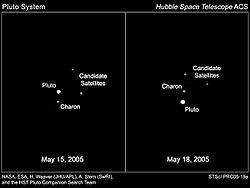Hydra (moon)
 Artist conception of Hydra (foreground), Pluto and Charon (background), and Nix (bright dot center left) | |
| Discovery | |
|---|---|
| Discovered by | Hubble Space Telescope Pluto Companion Search Team |
| Discovered in | June 2005 |
| Orbital characteristics[1] | |
| Semi-major axisa | 64 780 ± 90 km |
| Eccentricity | 0.005 ± 0.001 |
| Orbital period | 38.206 ± 0.001 d |
| Inclinationb | 0.22° ± 0.12° |
| Is a moon of | Pluto |
| Physical characteristics | |
| Mean diameter | 61 − 167 km[2] |
| Mass | 5×1016 − 2×1018 kg[3] |
| Mean density | unknown |
| Rotation period | unknown |
| Axial tilt | unknown |
| Albedo | 0.04 − 0.35 (assumed)[4] |
| Apparent magnitude | 22.9 to 23.3 (measured)[4] |
| Surface temp. | 33-55 K |
| Atmosphere | none |
|
| |
| a Relative to the Pluto-Charon barycenter. b Relative to Pluto's equator (also Charon's orbital plane). | |
Hydra is the farthest moon of Pluto. It was found along with Nix in June, 2005 by the Hubble Space Telescope's Pluto Companion Search Team, which is composed of Hal A. Weaver, Alan Stern, Max J. Mutchler, Andrew J. Steffl, Marc W. Buie, William J. Merline, John R. Spencer, Eliot F. Young, and Leslie A. Young. The discovery images were taken on May 15, 2005 and May 18, 2005; the moons were independently found by Max J. Mutchler on June 15, 2005 and Andrew J. Steffl on August 15, 2005. The discoveries were announced on October 31, 2005, after confirmation by precoveries from 2002. The moons were provisionally designated S/2005 P 1 (Hydra) and S/2005 P 2 (Nix).[5][6]
The moon orbits the barycenter of the system in the same plane as Charon and Nix, at a distance of about 65,000 km. Unlike other moons of Pluto, its orbit is only nearly circular; its eccentricity of 0.0052 is small, but significantly non-zero. Its orbital period of 38.2 days.
Although its size has not been directly measured, calculations based on its brightness give it a diameter of between 61 km, if its reflectivity is similar to Charon's 35 percent, and about 167 km, if it has a reflectivity of 4 percent like the darkest objects.[2] At the time of discovery, Hydra was about 25 percent brighter than its sister moon Nix, which led to the assumption that its diameter was some 10 percent bigger.[7] Pre-discovery data from Hubble observations in 2002-3 inferred that Nix was the brighter moon.[1] However, Hubble observations in 2005-6, specifically targeting the dim moons, once again showed Hydra to be a little brighter.[4] Hydra appears to be grey like Charon and Nix, though Pluto is reddish.
The New Horizons mission visited the area of Pluto and photographed its satellites in 2015. Hydra was on the far side of Pluto and the pictures were less good than of the others.
The name Hydra was announced on June 21, 2006, in IAU Circular 8723,[6] along with the formal designation Pluto III. It was named after Hydra, the monster who guarded the waters of Pluto/Hades's underworld in Greco-Roman mythology.
Hydra (moon) Media
References
- ↑ 1.0 1.1 Buie, M.W. (2006). Grundy, W. M.; Young, E. F.; Young, L. A.; and Stern, S. A. "Orbits and Photometry of Pluto's satellites: Charon, S/2005 P1, and S/2005 P2 [sic]". Astronomical Journal. 132 (1): 290–298. arXiv:astro-ph/0512491. Bibcode:2006AJ....132..290B. doi:10.1086/504422. S2CID 119386667.(Final preprint)
- ↑ 2.0 2.1 H.A. Weaver (23 February 2006). S.A. Stern, M.J. Mutchler, A.J. Steffl, M.W. Buie, W.J. Merline, J.R. Spencer, E.F. Young and L.A. Young. "Discovery of two new satellites of Pluto". Nature. 439 (7079): 943–945. arXiv:astro-ph/0601018. Bibcode:2006Natur.439..943W. doi:10.1038/nature04547. PMID 16495991. S2CID 1456215.
- ↑ Based on the range of diameters from Buie et al. (2006), and densities ranging from 1 g/cm³ (ice) to 2 g/cm³ (Pluto).
- ↑ 4.0 4.1 4.2 Stern, S.A. (2006). Mutchler, M.J.; Weaver, H. A.; and Steffl, A.J. "The Positions, Colors, and Photometric Variability of Pluto's Small Satellites from HST Observations 2005-2006". Astronomical Journal: submitted. (Final preprint)
- ↑ IAU Circular No. 8625 describing the discovery
- ↑ 6.0 6.1 IAU Circular No. 8723 naming the moons
- ↑ Stern, Alan (15 May 2005). "Background Information Regarding Our Two Newly Discovered Satellites of Pluto". Hal Weaver (JHU APL), Max Mutchler (STScI), Andrew Steffl (SwRI), Bill Merline (SwRI), Marc Buie (Lowell Observatory), John Spencer (SwRI), Eliot Young (SwRI), and Leslie Young (SwRI). Planetary Science Directorate (Boulder Office). Archived from the original on 2020-08-01. Retrieved 2007-11-10.
- Steffl, A. J. (2006). Mutchler, M.J.; Weaver, H.A.; Stern, S.A.; Durda, D.D.; Terrell, D.; Merline, W.J.; Young, L.A.; Young, E.F.; Buie, M.W.; and Spencer, J.R. "New Constraints on Additional Satellites of the Pluto System". The Astronomical Journal. 132 (2): 614–619. arXiv:astro-ph/0511837. Bibcode:2006AJ....132..614S. doi:10.1086/505424. S2CID 10547358.(Final preprint)
Other websites
- Hydra Profile Archived 2007-08-01 at the Wayback Machine by NASA's Solar System Exploration
- NASA's Hubble Reveals Possible New Moons Around Pluto – Hubble press release
- Two More Moons Discovered Orbiting Pluto (SPACE.com)
- Pluto's Newest Moons Named Hydra and Nix (SPACE.com)
- Hydra at ESA/Hubble Archived 2007-01-14 at the Wayback Machine


